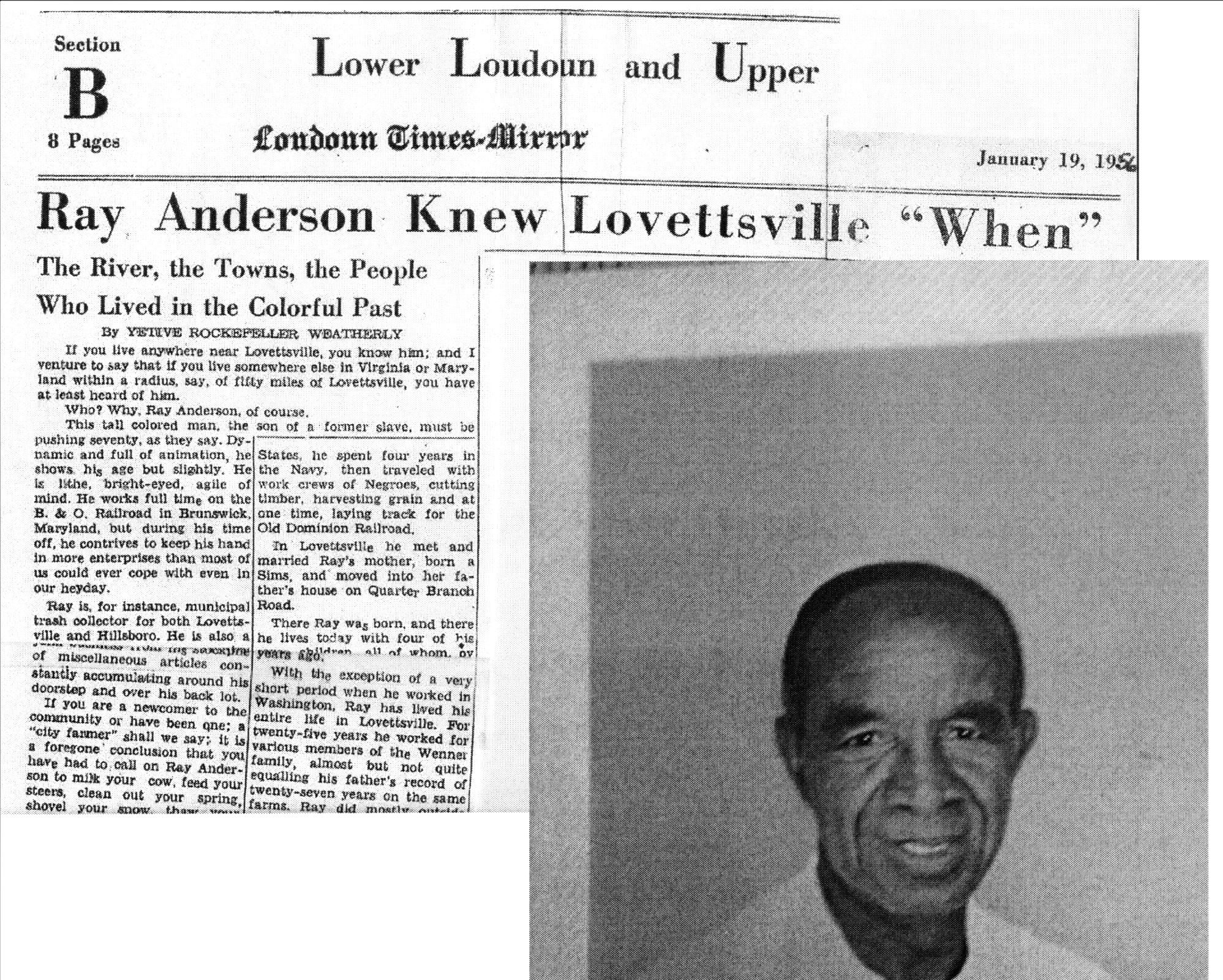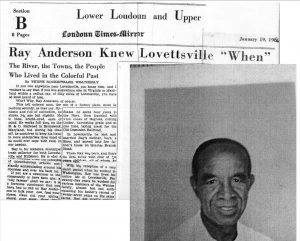By Claudette Lewis Bard
To talk about Ray Anderson is to talk about a Lovettsville legend, a highly-skilled and hard-working gentleman who was known, in the early to mid-20th century, by nearly everyone in Lovettsville and beyond. Additionally, he was the subject of an extensive newspaper article in the Loudoun Times-Mirror dated January 19, 1956, written by Yetive Rockefeller Weatherly. She described him as a “a tall, colored man, the son of a former slave, must be pushing seventy, as they say.” Weatherly also mentioned him several times in her book entitled, Lovettsville: The German Settlement. In her book, she described him as one with “a prodigious memory and a spellbinding knack for narration.” [1]
But for me, Ray Anderson was my great-great uncle and he was still being remembered at every family reunion I had ever attended. The reunions date back to the 1980s. And there were plenty of his descendants who remembered him because, after all, Ray and wife, Sarah Edna, had 14 children of which 12 lived to adulthood.
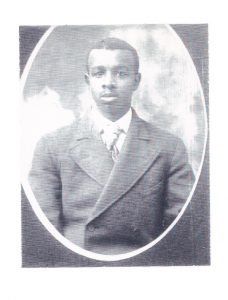 He and my great grandmother, Minnie Washington Anderson Waters, were brother and sister. Both were born and raised in Lovettsville. Ray remained there and was a life-long resident, occupying a home on Quarter Branch Road. Here is a brief history of the lives of Ray and Sarah Edna Anderson.
He and my great grandmother, Minnie Washington Anderson Waters, were brother and sister. Both were born and raised in Lovettsville. Ray remained there and was a life-long resident, occupying a home on Quarter Branch Road. Here is a brief history of the lives of Ray and Sarah Edna Anderson.
Ray Anderson
Ray Anderson was born Ray Von Anderson and he was the son of a slave. At the time when Ray was born, birth certificates were not issued in the state of Virginia. Births in Loudoun County were hand written in a document called Loudoun County, Virginia Birth Register. According to that register, Ray was listed as follows: Raven Anderson, colored female, [born] 12 August 1888. His father’s name was George W. Anderson, laborer; his mother was Sarah J. Anderson. George Anderson was the informant.[2]
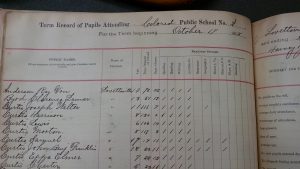
He received his education in Loudoun County’s segregated school system. The Lovettsville Colored School in 1898 was located at that time at South Locust and South Loudoun Streets. Ray was enrolled there at the age of ten. He was joined by his sisters Minnie Washington Anderson, Grace Anderson and Edith E. Anderson. There were about 28 children enrolled and the ages range from five to 18 years old. Since it was a one-room school house, more than likely, each row represented a grade. Ray studied spelling, reading, writing, and arithmetic. Other courses offered included grammar, geography, the history of Virginia, U.S. history, drawing and a subject that was abbreviated “Phys. & H.” His classmates included members of the Curtis, Dawson, Davis, Gray, Lee, Morgan, Streams, Randolph, and Robinson families. Their teacher’s last name was Harvey.[3]
In the 1900 census, once again, Ray was listed as female. His family unit was listed as follows: his father, George W. Anderson was a 48-year-old farm laborer and he was a widower. Ray’s brother, Louis William Etchison Anderson was a 20-year-old farm laborer and single. His sister, Edith E. Anderson was 16 years old. Another sister, my great-grandmother, Minnie W. Anderson was 13 years old. Ray was enumerated as Ray V. Anderson, daughter and the census record has the month and year of birth as August 1888. He was 11 years old.[4]
Sarah Edna Anderson
Ray’s wife Sarah Edna Anderson was born Sarah Edna Beaner on November 8, 1900, in Carroll County, Maryland. Her parents, David Beaner and Mahalia Young Beaner, were from Carroll County as well. A few years later, her brother was born. Known by his middle name throughout his life, Singleton Rodney Beaner was born about 1903. This close brother-sister relationship would endure throughout their lives; they appear to be the only offspring of the union between David and Mahalia Beaner.[5]
By 1910, David Beaner had moved and settled his family in nearby Frederick County, Maryland in the town of Point of Rocks and there was a noticeable change in David Beaner’s family structure. Mahalia was no longer living in the household. It was unclear if she and David were divorced or if she died. David Beaner was 42 years old and had married a second time in 1905 to Laura V. Beaner, who was 14 years his junior at 28 years old. This was her first marriage. Laura had not given birth to any children. Sarah Edna was now ten and her brother, Singleton Rodney was nine years old.
Often families move to certain areas because of work opportunities or family ties and perhaps this may have been the case for David’s relocation. The family of Albert and Sarah Beaner was listed next to David Beaner’s family in the census. Born in Virginia, Albert Beaner was a 71-year-old farm laborer who owned his home free of a mortgage. Albert could neither read nor write. He had been married to Sarah A. Beaner, age 59, for 45 years; she was born in Virginia as well. Sarah had given birth to seven children and only three survived. Two of their adult children resided with them. Their son, Joseph Beaner, was a 31-year-old single farm laborer and their daughter, Mary, was 30 years old and was also single. Both Joseph and Mary were born in Maryland and both children could read and write. Since Albert was 71 years old and Sarah was 59, this leads me to conclude these were David’s parents and he was Sarah’s third living child. I could not help but notice, all three children were given names from the Bible.[6]
Ray Anderson and His Siblings
Sarah Edna Beaner married Ray Anderson in about 1917 and she moved to Lovettsville. Soon afterwards, Ray registered for the draft due to the onset of World War I. According to his selective service card, he received an exemption that read “to care for his wife and his farm.”[7]
They lived in his childhood home which, from all accounts, was located at 39956 Quarter Branch Road. By 1920, Ray Anderson was a 31-year-old farm laborer, working on his own account and he owned his home free and clear of a mortgage. Sarah Edna was a 20-year-old housewife. They had two sons by now—Kenneth who was two and David was six months old. I remember David being called “Bo” throughout his life. Also enumerated in the household was Sarah Edna’s brother, Singleton Rodney Beaner, who earned his wages as a farm laborer and was 19 years old.
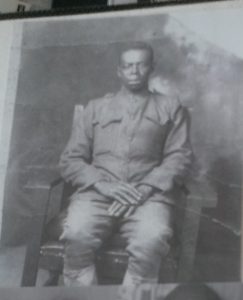
When I searched the pages of the 1920 census, I noticed that several of Ray’s siblings lived close by and were enumerated either on the same or the next page of the census. In the household next to Ray’s family lived his younger brother, Carl J.H. Anderson, 26, and his wife, Ann Gaither Anderson, 27. Carl Anderson was known during his lifetime as “Uncle Pete” and he was a World War I veteran.
Another brother who lived nearby was 40-year-old Louis William Etchison Anderson. He was known to me as Uncle Etch. Residing in his household were his wife, son, several generations of his family as well as non-family members, one of which was a school teacher. Uncle Etch’s household was an example of how extended families lived together and households often housed out-of-town boarders who were employed in the area in various occupations. Also noted among the persons enumerated was my maternal grandmother, Percie V. Waters, Uncle Etch’s niece, who was counted twice in the 1920 census. She was also counted in with her immediate family. Altogether, there were ten people living in Uncle Etch’s home.
On the same page and living nearby was the household of George and Grace Smith. Grace Anderson Smith was Ray’s 30-year-old sister. George, 31 years old, was the head of household and they had a one-month-old son name Richard. Through oral history, it was always told to me that Richard was their adopted son.[8]
Education During the 1930s
By the time the 1930 census was compiled, Ray’s family had a few more members. Four more children had been born to the couple. Ray Von Anderson Jr. was nine years old. The couple’s first daughter, Pearl V., was born in 1922 and was enumerated at eight years old. Helen H. was listed as five years old and their fourth son, Thomas C., was a two-year-old toddler. The additional children joined their two brothers, Kenneth, 12, and David, 11, to make up a family of eight. Along with enumerating each person living in the United States, census records often contained unique bits of information about each citizen. In this particular census, the enumerator asked each married person their age at their first marriage (I am not sure how that worked if someone was married a second time). Ray was 29 years old when he married Sarah Edna; she was 17.
Ray and Sarah Edna both envisioned a better life for their children and made sure they received an education. By the 1930s, the school for African-American students was located at the African Methodist Episcopal Chapel (AME Chapel) which was located on the Berlin Turnpike. The building still stands today. The AME Chapel was the focal point for many African Americans who lived and worked in Lovettsville. It served as a place of worship, a school, and was used for gatherings and meetings for Lovettsville’s Black citizens. Many of the teachers who taught there received their training at Storer College in nearby Harpers Ferry, West Virginia.
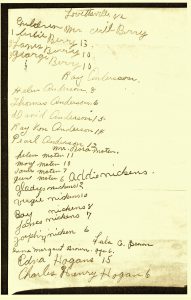
During the 1930s, in Virginia, as well as many parts of the country, there existed a segregated school system where Whites and Blacks attended separate schools. The schools for African-American students were deemed to be “separate but equal.” However, volunteers of a recently formed local project called the Edwin Washington Project have done extensive research brought on by the discovery in 2016 of dozens of boxes in an abandoned “colored” schoolhouse in Leesburg. The discovery of the heavily mold-infested and dusty contents contained over 10,000 pages of report cards, curriculum, class rosters and other information about the Loudoun County public school system. The period of time that the material covered was from shortly after the Civil War to desegregation in 1970. The findings have proven that the separate but equal concept did not exist and the schools for African-American students were far inferior to schools for White students.[9]
Many parents in Loudoun County, both Black and White, drew up petitions, requesting the school superintendent address problems that existed for their children. Examples of the complaints included in these petitions were as follows: the opening, closing or expanding of schools, teacher selection, transportation and safety, poor conditions and other miscellaneous items. It is suspected that a document found by the Edwin Washington Project pertaining to the Lovettsville Colored School was one such petition. The document contained the names of students enrolled at the AME Chapel school and their parents’ names. Ray Anderson and his children’s names were among them. The document was undated but based on the ages of the Anderson children listed, I would estimate that it was drawn up in the mid-1930s. Did they desire better transportation? Or perhaps they wanted a safer environment for their children while attending classes. Could they had been requesting more teachers? It is unknown as to what they were requesting since no other accompanying document was found. Nevertheless, the desire was there for a better educational environment.[10]
Tragedy and Life After Loss
By 1940, Ray and Sarah Edna’s family had grown even more. They had remained in their home on Quarter Branch Road during the Depression years, between 1930 and 1940. By 1940, Ray Anderson was a 51-year-old farmer. Sarah Edna was 40 years old and the census record indicated her occupation was a servant. However, this was crossed out and that leads me to believe she was a housewife taking care of her children. Kenneth was 22 years old, single, was a farm laborer, and had completed six years of schooling. His brother, David, was 21, had a 6th grade education and was a farm laborer. Ray Von Jr. was 20, had completed six years of schooling and worked on the farm. Their sister, Pearl, was 18 years old, had completed seven years of education and was a domestic worker in a private home.
The younger children attended school at the AME Chapel. Helen was 14-years old, a student and was in the 5th grade; Thomas, 13, was in the third grade; George Herbert, age 10, was in the second grade and another sister, Betty Jane, 9, attended school and was in the first grade. The other children were too young to have attended school: Shirley, 3, Ralph Lee, 2, and Sandra, six months old. Ray and Sarah Edna’s children totaled eleven.
Singleton Rodney Beaner, 39, Sarah Edna’s younger brother, had moved into the Ray Anderson household a few years earlier and continued to live there in 1940. His occupation was farm laborer.[11]
In 1941, Sarah Edna gave birth to another daughter by the name of Jackie. By 1942, Sarah Edna found herself pregnant and looking forward to a 13th child. But sadly, in November 1942, Sarah Edna suffered a cerebral hemorrhage during childbirth and lost her life and the life of her unborn child. She was 42 years old.[12]
One can only imagine the devastating impact her death had on the family and on Ray who was faced with the inconceivable weight of raising the several minor children left in his care. The next several years were recalled by his youngest daughter, Jackie. She spoke of what life was like not knowing her mother and what the family did to survive.
Jackie attended the Lovettsville Colored School at the AME Chapel as a toddler because there was no one at home to care for her. She recalled attending with her sister, Helen and the other siblings. Helen, at age 16, appeared to have taken over the role of her mother and was tasked with Jackie’s care. Jackie recalled how each row in the one-room schoolhouse was designated a grade. For example, row one would be the first grade, row two was the second and so on. During this time, Ray worked for the B & O Railroad in nearby Brunswick, Maryland. He worked at night and when he got off from work in the morning, he would drive his children to school. However, if for some reason, he had to work a little later, the children walked the several mile trek from their Quarter Branch Road home to school, in order to attend classes. When school let out in the afternoon, Uncle Carl, also known as “Uncle Pete,” who worked as a janitor at the nearby Lovettsville Elementary School (school for the White children), would transport the children back home.
Jackie recalled some of the conditions at school. During the winter months, each student had to bring a lump of coal for the stove in the school. This was because the school was not adequately supplied with fuel for the stove. There was no indoor toilet; an outhouse served as a bathroom. Water came from a well.[13]
Jackie fondly remembered Mrs. Mildred Gray as one of the dedicated teachers who taught at the school. Mrs. Gray was trained at Dunbar High School, the Miner Normal School, both in Washington, D.C. and also at Storer College. My research showed she taught during the 1943-1944 and the 1945-1947 school years. However, I believe she taught additional school terms as well. She died in 1989 and was aptly buried at the AME Chapel Cemetery, adjacent to the building where she once taught for so many years.[14]
The Lovettsville Colored School housed grades one through seven within its walls and continued until 1949 when it closed due to declining enrollment. Jackie recalled how she and her fellow classmates were then bused to nearby Waterford, Virginia. She recollected that she attended one-room schoolhouses until she went to Douglass High School in Leesburg. In 1955, as a teenager, Jackie moved to Doubs, Maryland, to live with her sister, Helen, and her family, where Helen continued to be the only mother Jackie ever knew. She finished her education in the Frederick County Public Schools and never returned to Virginia.[15]
Ray continued to live on Quarter Branch Road. By 1956, four of Uncle Ray’s 12 children lived with him. Two sons had served in the United States Armed Forces during World War II. Ray was well known in Lovettsville and the surrounding area for his story telling and his detailed recall of the history of Lovettsville, which included tales of the different families and even events that happened before he was born. In the mid-1950s, he continued to work for the B & O Railroad, but possessed knowledge and experience in other trades and professions as well. Junk dealer was one such trade. A cousin I spoke with several years ago recalled Ray’s stockpile of miscellaneous articles in his yard. My cousin George “Dicky” Young, who was Helen’s son, called Ray the Fred Sanford of his time. Fred Sanford was a character on the television show, Sanford and Son and his profession was junk dealer. It seemed Ray could be counted on to have any part for your car as well as parts for appliances and anything else that needed parts. He acquired such items from local auctions where he was an astute buyer, seller, and trader. Along with being an auto mechanic, Ray possessed a wide range of abilities including trash collector, window washer, butcher, painter, and a person who could remove your snow. With so many skills and such knowledge, it is no doubt Ray was a respected and valued member of the Lovettsville community.[16]
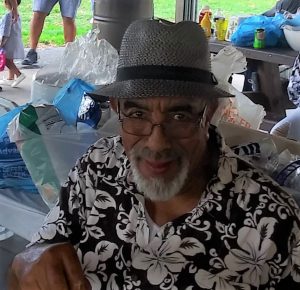
Unfortunately, George “Dicky” Young, at age 75, died in March 2021. I will miss talking to him at our family reunions, and I sincerely appreciate the memories he shared with me.
Another relative who lived in nearby Purcellville recalled her family trips to Ray’s home when her family’s car needed to be repaired. Of course, Ray was more than willing to oblige and, needless to say, he had the parts they needed. He put his auto repair knowledge to use and had the car running like new. She also recollected how he desired to move to Maryland because of concerns for his daughters. After all, Ray worked at night and, like any father, he was concerned about leaving teenagers alone without adult supervision. Would they be safe? On the contrary, their safety was not his only concern. He was concerned about teenage boys coming to visit his daughters, making a social call. The absence of his beloved Sarah Edna seemed to never get any better.
Ray Anderson died on May 15, 1960 of a cerebral hemorrhage. He was 71 years old. He was laid to rest in the AME Chapel Cemetery.[17]
*****
Although I never met him, I feel as if I knew him from all of the tales I have heard. He would be proud to know his descendants still gather every year for a family reunion in Frederick. Ray and Sarah Edna Anderson made sure their children were educated while dealing with the inequalities of a segregated school system. They raised sons who served their country honorably in World War II. Often times in those days, from what I have read, when such a heartbreaking event occurred in families, the family was separated and the children go to live with other relatives. But Ray managed to keep his family together and worked hard to provide for them, not only working for the B & O Railroad but having engaged in many other occupations using his numerous skills and know how. He was truly a highly regarded man. Knowing all of this about Ray, I can proudly say I am related to a Lovettsville legend.
ENDNOTES:
[1] Yetive Rockefeller Weatherly, “Ray Anderson Knew Lovettsville ‘When,’” Loudoun Times-Mirror, January 19, 1956. Yetive Rockefeller Weatherly, Lovettsville: The German Settlement, Lovettsville, 1976.
[2] Loudoun County, Va. Birth Register 1880-1896 (transcribed document) obtained from the Library of Virginia, 2010.
[3] Lovettsville Colored School Ledger courtesy of the Lovettsville Historical Society and Museum.
[4] U.S. Federal Census, Ancestry.com
[5] Frederick County, Maryland Death Certificates, Ancestry.com.
[6] U.S. Federal Census, Ancestry.com.
[7] U.S. Federal Census; Selective Service Record, Ancestry.com.
[8] U.S. Federal Census, Ancestry.com.
[9] Hannah Natanson, “Faded Records Tell Virginia’s Story of School Segregation: Reconstructing an Almost-Lost History in Loudoun County,” Washington Post, February 23, 2020.
[10] The Edwin Washington Project.
[11] U.S. Federal Census, Ancestry.com.
[12] Loudoun County, Virginia Death Certificates, Ancestry.com.
[13] Conversations with Jackie Williams.
[14] The Edwin Washington Project; Find-A-Grave.com.
[15] Conversations with Jackie Williams.
[16] Conversations with George “Dicky” Young.
[17] Loudoun County, Virginia Death Certificates, Ancestry.com

